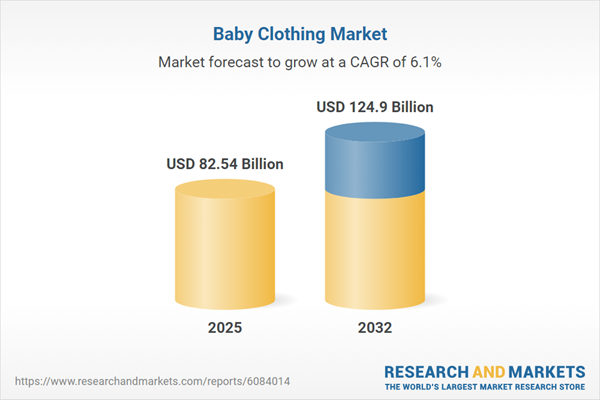Speak directly to the analyst to clarify any post sales queries you may have.
The baby clothing market is undergoing notable transformation as technology, heightened consumer awareness, and digital acceleration reshape industry dynamics. Senior decision-makers require precise market insights and actionable intelligence to remain agile in this evolving landscape.
Market Snapshot: Baby Clothing Industry Growth and Trends
The baby clothing market increased from USD 77.73 billion in 2024 to USD 82.54 billion by 2025 and is set to reach USD 124.90 billion in 2032, expanding at a CAGR of 6.10%. This growth is connected to innovation, shifting parental expectations, and evolving regional consumption patterns, positioning the baby clothing market as a dynamic arena shaped by rapid transformation and fast-changing value drivers.
Scope & Segmentation: Comprehensive Industry Coverage
- Distribution Channels: Boutique outlets, hypermarkets, specialty stores, supermarkets, official brand websites, e-commerce marketplaces, and social commerce channels each serve different segments of today’s buyer journey. Brands are leveraging these touchpoints to drive omnichannel sales and foster deeper consumer loyalty.
- Gender: Female, male, and unisex clothing offerings align with evolving consumer demand for both traditional and inclusive apparel, expanding accessibility and supporting diverse family needs.
- Material Types: Blended fabrics, pure cotton, organic cotton, and synthetic fibers present manufacturers and buyers with distinct sourcing strategies. Emphasis on organic and sustainable materials is reshaping procurement, production, and product messaging for concerned caregivers.
- Product Types: Bodysuits, baby accessories such as bibs and hats, footwear including booties and shoes, outerwear (from coats to lightweight jackets), and varied sleepwear options support cross-selling strategies while responding to specific usage requirements and seasonal trends.
- Regions: The Americas (United States, Canada, Mexico, Brazil, Argentina, Chile, Colombia, Peru) showcase complex regulatory and retail environments. Europe, the Middle East & Africa (including the United Kingdom, Germany, France, Italy, Spain, Netherlands, Sweden, Poland, Switzerland, United Arab Emirates, Saudi Arabia, Qatar, Turkey, Israel, South Africa, Nigeria, Egypt, Kenya) highlight the importance of cultural nuances and compliance. Asia-Pacific (China, India, Japan, Australia, South Korea, Indonesia, Thailand, Malaysia, Singapore, Taiwan) continues to expand, shaped by rising urbanization and evolving consumer profiles.
- Leading Companies: Carter’s, Inc.; H&M Hennes & Mauritz AB; Industria de Diseño Textil, S.A.; Gap Inc.; The Children’s Place, Inc.; PVH Corp.; Fast Retailing Co., Ltd.; Associated British Foods plc; Walmart Inc.; Amazon.com, Inc. These industry leaders anchor innovation, retail reach, and supply chain transformation across global markets.
Key Takeaways for Senior Decision-Makers
- Rising preference for sustainable, organic, and safe materials is spurring manufacturers to introduce recycled fibers, eco-friendly packaging, and transparent supply chains to meet both regulatory and consumer expectations.
- Digital and social commerce are reshaping how brands engage caregivers, supporting investments in omnichannel presence and virtual interaction tools that accelerate the buying journey and build brand affinity.
- Adoption of gender-neutral and inclusive product design expands addressable markets, fosters consumer loyalty, and enhances brand relevance across diverse demographics.
- Operational agility—through streamlined supply chains, rapid product launches, and robust logistics networks—enables stakeholders to keep pace with shifting demand and seasonal volatility.
- Adapting strategies to local regulatory requirements, cultural preferences, and varying retail infrastructures is vital for successful regional expansion and resilience in a complex international marketplace.
Tariff Impact: Navigating Trade Policy Changes in a Shifting Landscape
The introduction of new U.S. trade tariffs in 2025 has shifted global supply chain strategies for baby clothing. Decision-makers are increasingly evaluating domestic and nearshore production models to alleviate cost increases and supply disruptions. This policy adjustment has resulted in a reassessment of supplier agreements and logistics frameworks, driving partnerships focused on enhancing efficiency and regulatory compliance. Brands that rapidly align sourcing and operational processes with evolving trade requirements are positioned to sustain growth and achieve stability amid ongoing regulatory change.
Methodology & Data Sources
This report utilizes qualitative interviews with C-suite executives, in-person production facility site visits throughout North America and Asia Pacific, and quantitative surveys targeting both caregivers and retail buyers. Complementary secondary research validates findings, and rigorous data triangulation ensures confidence in all market intelligence. This comprehensive, multi-pronged methodology supports decision-grade insights for industry leaders.
Why This Report Matters
- Allows executives to benchmark evolving practices, from material innovation to retail channel integration and adaptive design, responding effectively to market transformation.
- Equips strategy and planning teams with targeted intelligence on regulatory shifts, regional differences, and consumer demand drivers for robust market entry and portfolio decisions.
- Empowers operational leadership with actionable insights to optimize supply chain management and digital-commerce integration across global and local contexts.
Conclusion
In a rapidly changing business environment, the baby clothing industry’s future depends on strategic foresight and operational agility. Industry participants who successfully anticipate shifts and act decisively are best placed to leverage emerging opportunities and mitigate evolving challenges.
Table of Contents
3. Executive Summary
4. Market Overview
7. Cumulative Impact of Artificial Intelligence 2025
Companies Mentioned
The companies profiled in this Baby Clothing market report include:- Carter's, Inc.
- H&M Hennes & Mauritz AB
- Industria de Diseño Textil, S.A.
- Gap Inc.
- The Children's Place, Inc.
- PVH Corp.
- Fast Retailing Co., Ltd.
- Associated British Foods PLC
- Walmart Inc.
- Amazon.com, Inc.
Table Information
| Report Attribute | Details |
|---|---|
| No. of Pages | 182 |
| Published | November 2025 |
| Forecast Period | 2025 - 2032 |
| Estimated Market Value ( USD | $ 82.54 Billion |
| Forecasted Market Value ( USD | $ 124.9 Billion |
| Compound Annual Growth Rate | 6.1% |
| Regions Covered | Global |
| No. of Companies Mentioned | 11 |









